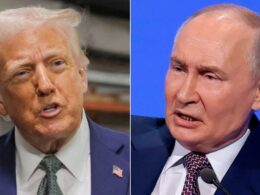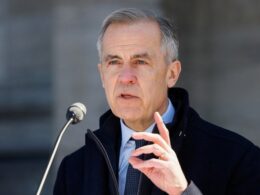Unlock the Editor’s Digest for free
Roula Khalaf, Editor of the FT, selects her favourite stories in this weekly newsletter.
“Liberation Day” has quickly turned into Libation Day for many Wall Street analysts, who are being forced to take Donald Trump both seriously and literally.
The tariffs announced went far further than anyone had expected. As JPMorgan’s Michael Feroli points out, a static calculation implies that these tariffs would raise almost $400bn in taxes, relative to GDP terms the biggest tax increase since the 1969 Revenue Act.
It will increase inflation by 1-1.5 percentage points and take the average effective tariff rate back to 23 per cent — the highest in a century.
This alone could be enough to push the US economy into a recession, Feroli warns:
The resulting hit to purchasing power could take real disposable personal income growth in 2Q-3Q into negative territory, and with it the risk that real consumer spending could also contract in those quarters. This impact alone could take the economy perilously close to slipping into recession.
And this is before accounting for the additional hits to gross exports and to investment spending. Headlines about retaliatory measures by US trading partners are already coming out, and we expect to learn more in coming days. The somewhat confusing nature of today’s news, coupled with uncertainty over how long these tariffs will remain in place, should make for an even less friendly environment for investment spending (though that is one way to narrow the saving — investment imbalance and hence narrow the current account deficit).
We plan to revisit our forecast later this week.
We’ve already written about the clownish methodology underpinning the calculations of the “reciprocal” tariffs, and it seems that the sell-side is also pretty stunned by the bizarre approach.
Here are the three main conclusions by Deutsche Bank’s George Saravelos:
First, the US administration is squarely focused on penalizing countries with larger trade deficits in goods (services are ignored). This determination is highly mechanical, rather than a sophisticated assessment of tariff and non-tariff barriers. It is also in line with the declaration of a national emergency on the trade deficit used as a legal justification for the tariffs.
Second, there is a very large disconnect between communication in recent weeks of an in-depth policy assessment of bilateral trade relationships with different countries versus the reality of the policy outcome. We worry this risks lowering the policy credibility of the administration on a forward-looking basis. The market may question the extent to which a sufficiently structured planning process for major economic decisions is taking place. After all, this is the biggest trade policy shift from the US in a century. Crucially, major additional fiscal decisions are lining up over the next two months.
Third, the tariff calculation approach arguably makes for a more free-wheeling and open-ended nature to potential trade negotiations in coming months. It seems there are no specific and identifiable policy asks per se but ultimately a desire to reduce bilateral trade imbalances.
Saravelos points out that the Trump administration’s crude approach to calculating the tariffs “raises serious concerns about policy credibility” and thus undermines the dollar. As he emphasises, that the dollar is dropping in tandem with US equities is “extremely damaging” for a global investment community that is still extremely long US assets.
Barclays analysts are also reeling from tariffs that were both higher than expected, and more weirdly calculated than anyone would have thought possible, even by this administration.
However, their main point is that while tariffs are mostly priced into markets, the danger that this tips US and Europe into recession is still underestimated by markets.
Recession risk on the rise. These new tariffs and the lingering trade policy uncertainty dampen the global economic outlook, both globally and in Europe. However, the statements from authorities and the way the final tariffs were arrived suggests that there may be room for negotiations. So it is possible the announced tariffs may be seen as a ceiling and may go lower from here, although potential retaliation by US trading partners would add to downside growth risks. Policy support from central banks and government is also to be expected, which could mitigate some of the drag from the trade war. But overall, our economists see downside risks to their growth forecasts . . .
. . . Tariffs risk largely priced in, recession risk less so. As discussed in our latest Who Owns What, equities were already pricing-in some tariffs risk, with main indices off the highs and significant rotation under the hood at the sector level. SPX down 8% implies ~25% of recession priced-in already, but arguably, SX5E still up 8% ytd may have more catch-up to the downside if a recession becomes reality. This is particularly the case as tactical HF/CTA positioning on Europe is higher than for the US, although LO/Retail positioning is far more crowded for the US. In both regions, equities typically fell ~35% peak to trough during recessions, but we are not quite there yet, and further market pain may force some policy u-turn from Trump at some point.
Steven Blitz at TS Lombard also reckons this is a is a “recession-producing” set of measures for the US economy, but fears even this may miss the broader implications.
The Fed is not inflating to offset tariffs — the whole point is to create pain to force reshoring. They ease when payrolls decline, meaning after recession begins. Trump appears willing to accept this risk for the eventual reward from reshored activity.
For capital market participants, tariff tinkering from here is besides the point. They are repricing against Trump breaking the trade/dollar contract that has ruled for 40 years. A higher price to hold US dollar assets is likely demanded and that, in turn, creates higher hurdles to reach Trump’s promised land. Among the things Trump gets wrong with tariff nostalgia, is that then the US was a net exporter of capital, it is a net debtor nation now.
. . . Trump is right in saying the game is rigged against the US, but the first rule of an operation is that the patient comes out healthier. The damage from his tack to reset trade may very well create a worse, less healthy outcome. There is more to write, and we will in the days to come.
We’ll update this post with more sell-side reaction as it filters in.
Source link









